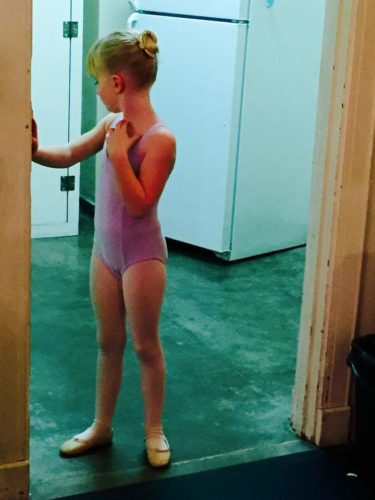When I picked my second-grader up from school the other day, her eyes looked tired, her nose was red from running all day, and she had a cough. She has asthma, and it is exacerbated when she gets a cold. She needed some mommy triage, and fast. I asked her how she felt and decided what I could do to help: Kleenex. Thermometer. Hot soup. A series of steps and questions to help her.
When my daughter started dance classes this fall, she had new teachers and new peers. Her classes were back-to-back and on opposite sides of the building, so she’d have to get to the second class on her own, greet the teacher, and find a spot next to a new friend, all within about five minutes. When I walked her into the building, she looked to me with tears threatening to spill over her lashes and grabbing her stomach. She said she was scared. I said, ‘Don’t worry. You’ll be fine!’
I would never respond to an asthma attack by saying, “Don’t worry!”, but my natural response to worry or anxiety was to just…not worry.
My daughter has asthma, so I know that when she has a flare-up, I need to help her. She also has anxiety, and new situations are challenging for her to confront. Why did I react so differently in these two situations? I would never respond to an asthma attack by saying, “Don’t worry!”, but my natural response to worry or anxiety was to just…not worry.
It wasn’t until I talked to her pediatrician at her annual check-up and commiserated with other mothers that I knew I needed a better strategy. I wanted her to understand that fear is a good thing, that this primal emotion will serve her well in many situations. She’s only seven, which means that she has a whole lotta life and a whole lotta new situations ahead. I wanted her to be competent and independent! Her anxiety about everyday situations–knocking on a friend’s door to play, trying new things, going to sleep on her own–was occupying a bigger and bigger part of her mind. Saying ‘Don’t worry!’ wasn’t an effective strategy any more than saying, ‘Just breathe!’ would help her through an asthma attack. I also knew I didn’t want to reinforce the worry by allowing her to skip potentially anxiety-inducing moments that were otherwise safe and even good for her.
I needed more than two words to help her flip the worry script in her mind.
Being the book nerd that I am, I turned to books: One for me and one for her. What to Do When You Worry Too Much is part story, part interactive workbook recommended for age 6-12. This book normalizes worry and focuses on empowering the child to confront worries that interfere with everyday life. From the very first pages, she was delighted to find that she wasn’t the only kid with worries!

While we worked on her worry book, I picked up a copy of Freeing Your Child From Anxiety, by Tamar Chancy. This book, for toddlers through teens, was my hallelujah moment in understanding my kid’s anxiety. Chansky writes that while childhood anxiety is at an all-time high, we can help our kids become competent and confident by managing their worry.
As we both worked through our “worry research,” I learned these three things from Chansky’s book to help her rewrite the worry script.
3 Tips for Responding to Anxiety in Your Child
“What is your worry telling you?”
Asking this question helps her to separate the situation from the story that worry is telling her. When it’s time to go to a new dance class, worry says, ‘Stop! This is scary!’ Exposing the worry script introduces the fact that it is just one way to approach the situation and opens the door to alternative approaches.
“Let’s compare.”
After you’ve exposed worry’s script, ask her to create her own script, like, ‘Shiny tap shoes are fun! You might meet your new best friend in class!’ This approach can replace the less effective ‘Don’t worry!’ with a side-by-side comparison of worry with reality. This step also reminds her that she is in charge of her actions, not worry.
“Give it a try.”
Once I replaced ‘Don’t worry!’ with an actual conversation about the worry, I asked her to try new things one step at a time. For the dance class scenario, I started by dropping her off at the first class, waiting outside, and then walking with her to the new class door and sending her in on her own. The long scary hallway was confronted, and she met her smiling teacher on the other side. Cue the shiny tap shoes. Having realized she could find her way from one class to the other, I left her to do it on her own the following week. When I picked her up, she exclaimed, ‘That wasn’t bad at all!’

If you have an anxious child, don’t worry (kidding!); you’re not alone. This strategy takes time, but little-by-little she is learning to trust herself. Most importantly, helping her write a new script to facing her anxiety is giving her the skills she needs to build confidence and independence for a lifetime.












You are such a breath of fresh air, I love how you parent, wish you mother was as smart as you are about parenting!!